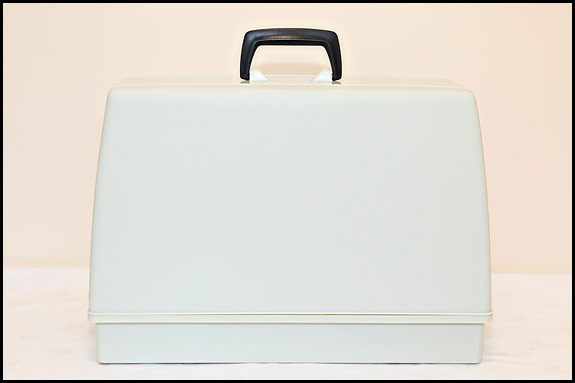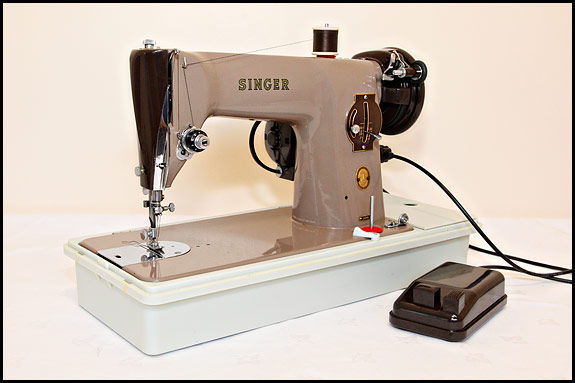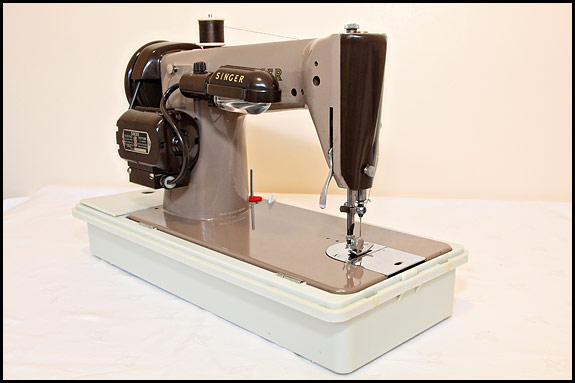

This is a rather nice 1949 Singer 201K hand-crank and it’s the latest machine to go on the “Singers for sale” page. It’s also missing its bottom spool pin in these pictures ‘cos I forgot to replace it before I took them, but there you go …
Anyhow, having got that embarrassment out of the way, let me say that it’s customary for those flogging a 201, particularly on Ebay, to tout it as a “semi-industrial” machine. It’s also the done thing to point out how many thicknesses of denim, leather, rhinoceros hide, chain mail or whatever a 201 will “sail through”, but it’s a lovely evening here and I don’t want to spoil it by going off on one about that just now. Suffice it to say that not so very long ago, it seemed to be only 201s that were hyped up like that. Now 99’s and 185’s are, regularly, so it’s surely only a matter of time before both the Barbie and the Hello Kitty sewing machines are rated “semi-industrial” too.
The reality of the 201 is that it’s a beautifully-engineered machine which is so well made it’s amazing that Singer could ever sell the things at a profit. It’s also generally held to be the best domestic sewing machine Singer ever made, it’s true that with the right needle and the right thread it’ll sew pretty much anything you can get under the presser foot, and it was certainly designed to take a lot of use. But not eight hours a day five days a week use. For that you still need an industrial machine, and they tend to be bigger, heavier, uglier and a great deal more expensive.
Put simply, if the 201 was a carpet, it’d be rated Heavy Domestic.
So, given that it’s “only” a straight-stitch machine like the 15 or the 66, you can be forgiven for wondering what the big deal is. Well, to anyone with a precision engineering background who works on sewing machines (e.g. me), the big deal is the all-metal, all-gear drive and a rotary hook. To most people who use one, the big deal is that they run beautifully, they sew a lovely stitch, they have same-stitch-length reverse, and you can drop the feed dogs on them.
I’ll do a separate post sometime about why the rotary hook of a 201 is an improvement on the reciprocating hook of a 66. However, die-hard fans of the 15 will already be muttering that what matters more is whether your bobbin’s horizontal or vertical, so for now I’ll just say that I do understand their argument about the 90 degree bend in the thread path, but speaking as an engineer, rotary motion beats reciprocating motion any day. So there.
The all-metal all-gear drive thing’s a no-brainer though. “All-metal” is good because metal gears don’t shred like horrible plastic ones can and do. And as to the all-gear drive, the handwheel of a 15, a 66 or a 99 moves your needle, your feed and your bobbin via an ingenious system of levers, cranks and cams. On a 201 it’s all done by shafts and gears, which is probably more efficient and is certainly far more elegant from the design point of view.
So it’s all good as far as I’m concerned, whether your 201 be the original Mk1 cast iron one or the later more modern-looking aluminium-bodied Mk2. Elsie likes ’em too, which explains the presence of the Mk1 in the 7-drawer treadle base in the front room and the Mk2 in the No46 treadle cabinet in The Sewing Room, which in fact she’s using as I type this. Doing something with a Swiss zigzagger, since you asked. Which might shortly be for sale …









You must be logged in to post a comment.